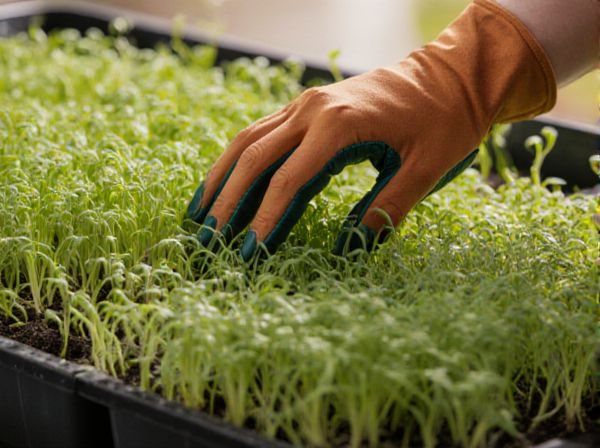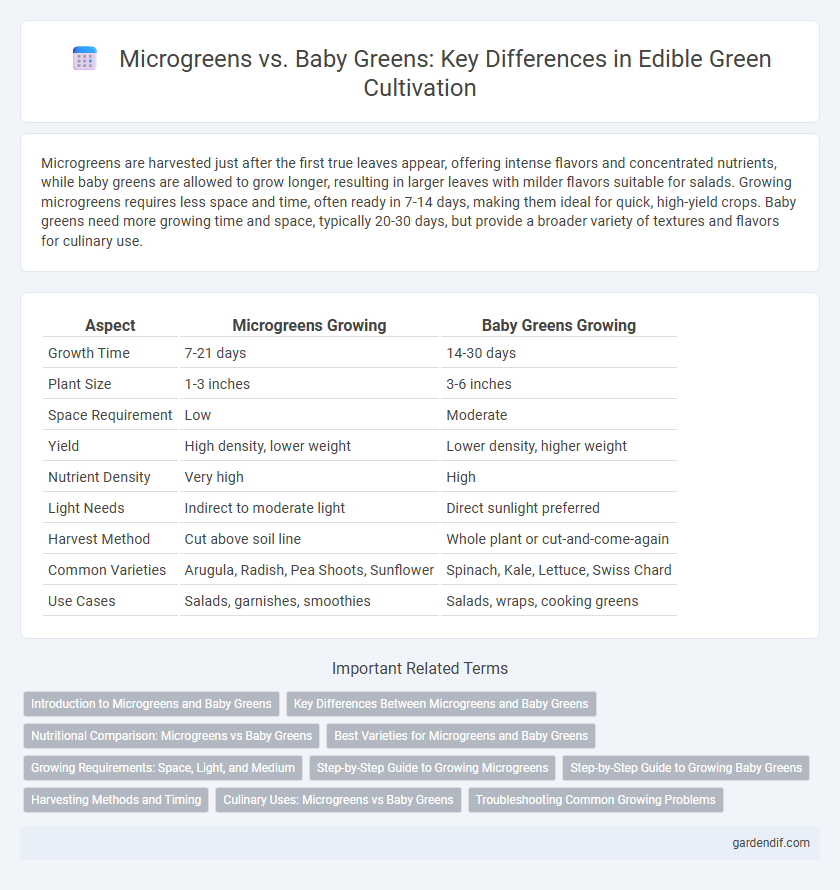
Microgreens growing vs baby greens growing Illustration
Microgreens are harvested just after the first true leaves appear, offering intense flavors and concentrated nutrients, while baby greens are allowed to grow longer, resulting in larger leaves with milder flavors suitable for salads. Growing microgreens requires less space and time, often ready in 7-14 days, making them ideal for quick, high-yield crops. Baby greens need more growing time and space, typically 20-30 days, but provide a broader variety of textures and flavors for culinary use.
Table of Comparison
| Aspect | Microgreens Growing | Baby Greens Growing |
|---|---|---|
| Growth Time | 7-21 days | 14-30 days |
| Plant Size | 1-3 inches | 3-6 inches |
| Space Requirement | Low | Moderate |
| Yield | High density, lower weight | Lower density, higher weight |
| Nutrient Density | Very high | High |
| Light Needs | Indirect to moderate light | Direct sunlight preferred |
| Harvest Method | Cut above soil line | Whole plant or cut-and-come-again |
| Common Varieties | Arugula, Radish, Pea Shoots, Sunflower | Spinach, Kale, Lettuce, Swiss Chard |
| Use Cases | Salads, garnishes, smoothies | Salads, wraps, cooking greens |
Introduction to Microgreens and Baby Greens
Microgreens and baby greens are young vegetable greens harvested at different growth stages, with microgreens picked shortly after the cotyledon stage and baby greens harvested later with more developed leaves. Microgreens typically offer a concentrated nutrient profile and intense flavors, making them popular in gourmet dishes, while baby greens are valued for their tender texture and mild taste, often used in salads and smoothies. Both microgreens and baby greens require minimal growing space and time, making them ideal for urban farming and home gardening.
Key Differences Between Microgreens and Baby Greens
Microgreens are harvested shortly after the cotyledon leaves develop, typically within 7-21 days, while baby greens mature longer, often 21-40 days, resulting in larger leaves and more complex flavors. Microgreens offer concentrated nutrients and vibrant colors, grown densely on trays or soil, while baby greens require more space and offer a milder taste with higher fiber content. The key differences between microgreens and baby greens lie in their growth duration, plant size at harvest, nutrient profiles, and culinary applications.
Nutritional Comparison: Microgreens vs Baby Greens
Microgreens contain higher concentrations of vitamins, minerals, and antioxidants compared to baby greens, with studies showing they can have up to 40 times more nutrients. Baby greens provide larger portions and tend to offer a well-rounded nutrient profile but with lower density per weight. The dense nutrient content in microgreens makes them a potent addition to diets focused on boosting micronutrient intake.
Best Varieties for Microgreens and Baby Greens
Microgreens like radish, sunflower, and pea shoots are prized for their intense flavors and rapid growth, making them ideal for quick harvests within 7-14 days. Baby greens such as arugula, kale, and spinach offer tender textures with more developed flavors, requiring longer growth periods between 14-30 days. Choosing the best varieties depends on desired taste and growth time, with microgreens focusing on vibrancy and nutrient density while baby greens emphasize leaf size and culinary versatility.
Growing Requirements: Space, Light, and Medium
Microgreens require minimal space and can thrive in shallow trays under moderate light, making them ideal for indoor or small-scale growing setups, with a lightweight, well-draining growing medium like coconut coir or peat moss. Baby greens need more substantial space for root expansion and consistent, bright natural light to develop fully, often grown in deeper containers or beds with nutrient-rich soil for sustained growth. Both microgreens and baby greens prefer a humid environment and well-aerated medium, but baby greens demand a longer growing period and more maintenance to optimize texture and flavor.
Step-by-Step Guide to Growing Microgreens
Microgreens growing requires a precise, fast-paced process involving soaking seeds, evenly spreading them on a seedling tray with a shallow growing medium, and maintaining consistent moisture without waterlogging. Germination occurs within 3-7 days under optimal light and temperature conditions, followed by harvesting when cotyledons develop, usually between 7-14 days. Compared to baby greens, microgreens demand less space and time, making them ideal for compact urban farming and high-yield edible production.
Step-by-Step Guide to Growing Baby Greens
Growing baby greens involves planting seeds more densely than microgreens and allowing them to mature for 10 to 21 days before harvesting, resulting in larger, nutrient-rich leaves. Start by selecting a well-draining growing medium, evenly spreading seeds, and maintaining consistent moisture without waterlogging to promote healthy root development. Provide 4-6 hours of indirect sunlight or use grow lights, thin seedlings if necessary to prevent overcrowding, and harvest by cutting leaves above the soil line when they reach 2-4 inches in height.
Harvesting Methods and Timing
Microgreens are typically harvested within 7 to 14 days after germination when the first true leaves appear, utilizing scissors to cut just above the soil line for a tender texture and concentrated flavor. Baby greens require a longer growth period of 14 to 30 days, allowing leaves to develop more fully, and are harvested by cutting the entire plant at the base or by selective leaf picking to promote continuous growth. Precise timing and careful cutting techniques in both microgreens and baby greens optimize flavor, nutrient density, and overall yield.
Culinary Uses: Microgreens vs Baby Greens
Microgreens offer intense flavors and vibrant colors, making them ideal for garnishing dishes, enhancing salads, and adding a burst of nutrition to sandwiches and smoothies. Baby greens provide a more substantial texture and mild taste, well-suited for salads, sauteed dishes, and as a base for dressings and pestos. Chefs favor microgreens for delicate presentation and concentrated taste, while baby greens excel in recipes requiring bulk and a tender bite.
Troubleshooting Common Growing Problems
Microgreens are more sensitive to overwatering, which often leads to mold and fungal growth, while baby greens require consistent moisture to avoid wilting and nutrient deficiencies. Both crops benefit from proper airflow and adequate light to prevent leggy, etiolated growth and damping-off disease. Implementing precise humidity control and using sterile growing mediums significantly reduces pest infestations and bacterial issues common in microgreens and baby greens cultivation.
Microgreens growing vs baby greens growing Infographic

 gardendif.com
gardendif.com